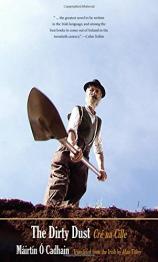The Dirty Dust
Review
The Dirty Dust
One of the joys of book reviewing is that, every once in a while, you come across a work you hadn’t heard of and weren’t expecting, and that work is so surprising and delightful that you can’t wait to tell others about it. Not long ago, I received a copy of THE DIRTY DUST, a 1949 novel originally written in Irish by Máirtín Ó Cadhain. I hadn’t heard of Ó Cadhain but learned, thanks to blurbs from Colm Tóibín and John Banville and from my research, that he was one of the most celebrated Irish-language novelists of the 20th century. As I began reading, I understood why this novel, now in its first-ever English translation, was so notorious. How often does one encounter a book in which all the characters are dead and buried? THE DIRTY DUST has as many characters as a Robert Altman film and creatively profane language that anticipates the vulgar poetry of David Mamet.
But all of this would have been nothing more than a gimmick, as would Ó Cadhain’s decision to tell his story almost entirely in dialogue, if it hadn’t been for the novel’s higher purpose. Set during World War II, THE DIRTY DUST is a vivid portrait of prejudice and class conflict in rural Ireland at a time of upheaval so immense that not even bickering neighbors in their graves can stop talking about the changes and injustices taking place above ground.
"[W]hat carries you along in THE DIRTY DUST is the rhythm of the prose, the cadences of the insults and vernacular, and the intricate portrait of the upheavals of the mid-20th century."
And, boy, do these people like to talk. Many of the characters in this devastating satire are the types of people who say, “But to cut a long story short,” and then proceed to talk at length, with as many details and digressions as possible. Anyone who expected to rest in peace after dying didn’t know the noisy neighborhood he or she was moving into. In fact, graveyard placement is one of the more contentious topics. Ó Cadhain begins the novel from the perspective of the freshly dead Caitriona Paudeen. She tells us that she hopes she’s in the Pound Grave, the one that costs the most to be buried in. Her relatives better not have stuck her in the Fifteen Shilling or, heaven forbid, the Ten Shilling plot, where the poor or just plain cheapskates stick their loved ones. What kind of world is it, Caitriona wonders, in which she dies first --- she was 71 --- and her rotten sister, Nell, lives on and stands to inherit the money of their oldest sister, Baba, who is alive and well at age 93 in America? Nell may be my sister, Caitriona says, “but I hope and pray that not one corpse will come to the graveyard before her.”
You’d think that death would put an end to woe and resentment, but not for this crew. Caitriona and others fret that their graves won’t be graced with crosses made of the coveted Connemara marble. She worries about her son, Patrick, whose wife is a lousy housekeeper and probably won’t care for him properly now that Caitriona is gone. The deceased schoolmaster fears that his wife will break her promise to him and remarry. A woman not known for her intellect stands for election in the Fifteen Shilling plot, much to the horror of Caitriona and others.
But amidst all the pettiness and squabbles involving people with names like Blotchy Brian and Huckster Joan, more serious topics are debated. There’s talk about the IRA. Some people lament that their children married Italians or blacks or, in one case, a “slylock Jew [sic].” And some of these residents of the dust debate the pros and cons of Hitler’s march across Europe.
This is not a book you read for plot. Little happens, and the structure of the chapters gets repetitive after a while. Someone new dies, and he or she updates the other corpses on events above ground. The middle chapters begin with a reckoning of sorts from someone who calls himself The Trumpet of the Graveyard. And sections often end with Caitriona learning of some new indignity and shouting, “I’m going to burst!”
But what carries you along in THE DIRTY DUST is the rhythm of the prose, the cadences of the insults and vernacular, and the intricate portrait of the upheavals of the mid-20th century. The wisdom of this canny, extraordinary book is its recognition that some situations are so overwhelming and engender such a feeling of helplessness that all you can do is talk about them.
Reviewed by Michael Magras on March 26, 2015
The Dirty Dust
- Publication Date: March 24, 2015
- Genres: Fiction, Historical Fiction
- Hardcover: 328 pages
- Publisher: Yale University Press
- ISBN-10: 0300198493
- ISBN-13: 9780300198492




